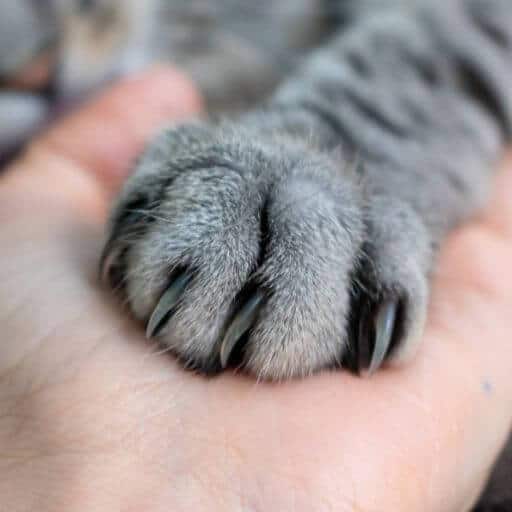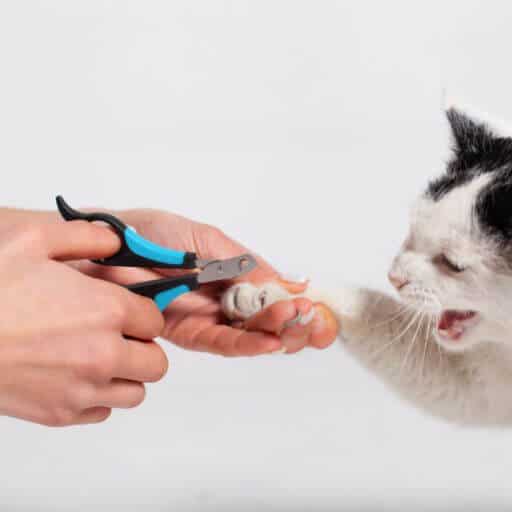Cat claws serve multiple functions, such as aiding in climbing, scratching, and hunting. Despite the important role of claws in a cat’s life, many cat guardians aren’t sure how to care for them. Read on to learn all about your cat’s claws.
Cats’ claws are an essential part of their anatomy, and they use them for self-defense, hunting, and marking their territory. Claws are made of keratin, the same material that makes up human nails and hair. But, unlike human nails, cats’ claws are retractable, which means they can extend and retract them as needed. This ability helps protect Kitty’s claws from wear and tear and allows her to move silently when hunting prey.
While cats’ claws are vital for survival in the wild, they become problematic in indoor cats when Kitty causes damage to the furniture. Some cat guardians choose to declaw their pets to prevent this damage, but this extreme procedure is controversial as it causes long-term physical and emotional problems for the cat. Instead, cat owners can take steps to keep their cats’ claws healthy and train them not to damage their homes. Thankfully, declawing is falling out of favor among cat people and vets.
Read more: Why declawing is bad for your cat
Anatomy of Cat Claws
Understanding the anatomy of cat claws is important for cat guardians to maintain their cats’ overall health and well-being.
Structure
A cat’s claw is made up of several parts, including:
- Keratin: The hard, protective outer layer of the claw.
- Quick: The living tissue inside the claw that contains blood vessels and nerves.
- Furrow: The groove in the claw that allows it to retract and extend.
- Digital cushion: The pad of tissue at the base of the claw that acts as a shock absorber.
Cat claws are retractable, which means they can be extended and pulled back as needed. This allows cats to keep their claws sharp and protected when not in use. When a cat needs to use its claws, it can extend them quickly and efficiently. This functionality is why you don’t see cat claws get worn down like dog claws do.

Purpose of Cat Claws
Cats are known for their sharp claws, which they use for a variety of purposes.
Hunting
Cats are natural hunters, and their claws play a vital role in their hunting behavior. They use their claws to catch prey, hold it down, and deliver a fatal bite. The sharpness of their claws allows them to climb trees and jump great distances in pursuit of prey.
Self Defense
Cats use their claws for self-defense when they feel threatened or afraid. They can swipe at an attacker with their claws, causing significant damage. The retractable nature of their claws allows them to keep them hidden until they need them.
Climbing and Exploration
Cats are excellent climbers, and their claws help them to climb trees, fences, and other objects. They also use their claws to explore their environment, testing surfaces for stability and texture.
Marking Territory
Cats use their claws to mark their territory by scratching on surfaces. The scent glands in their paws release pheromones that mark the area as theirs. This behavior is essential for communication with other cats and for establishing their territory.

Cat Claw Care
Proper care of cat claws is important for maintaining their health. Cats can get infections or develop deformities in their paws which can lead to problems with walking and joint issues if they’re are not properly looked after.
Keeping your cat’s claws healthy is essential for their overall well-being. Here are a few tips to help you take care of their claws.
- Regularly trimming your cat’s claws can help prevent them from becoming overgrown and causing Kitty discomfort or injury.
- Provide your cat with appropriate scratching surfaces, such as scratching posts or pads, to prevent them from damaging furniture or other items in your home.
- Claw caps are another option to keep things safe from scratching cats.
Related Post: Claw Caps Cool or Cruel
Scratching Posts and Alternatives
Cats naturally scratch, and providing them with a suitable outlet for this behavior is crucial. Scratching posts and alternatives can help protect your furniture and keep your cat’s claws healthy.
What to look for in a good scratching post:
- Size: The scratching post should be tall enough for your cat to stretch out fully. It should also be sturdy enough to support your cat’s weight.
- Material: Cats prefer different materials for scratching. Some prefer sisal rope, while others prefer cardboard or carpet. Consider your cat’s preferences when choosing a scratching post or alternative.
- Location: Place the scratching post in an area where your cat spends a lot of time. This will encourage them to use it instead of your furniture.
Related Post: How to Prevent Your Cat from Scratching Your Furniture
Claw Clipping
Clipping your cat’s claws is an essential part of their grooming routine. Here are a few things to keep in mind:
- Tools: Use special cat nail clippers to avoid hurting your cat. Do not use regular scissors or clippers.
- Frequency: Clipping your cat’s claws once every two to three weeks is usually sufficient.
- Technique: Hold your cat’s paw firmly and clip the tip of the claw. Be careful not to cut the quick, which is the pink part of the claw that contains blood vessels and nerves. If you accidentally cut the quick, apply styptic powder and pressure with a cotton ball to stop the bleeding. It shouldn’t be a major issue. It’s like cutting your nail too short.
Related Post: How to Clip a Wiggly Cat’s Claws
Common Claw Issues
Like any other body part, Kitty’s claws can develop problems over time. Here are some common claw issues that cat guardians should be aware of.
Overgrown Nails
Overgrown nails are a common problem among cats, and they can cause discomfort and pain. Long nails can also get stuck in carpets, furniture, or other surfaces, leading to injury or damage. To prevent overgrown nails, cat owners should regularly trim their cat’s claws using a clipper or grinder. If the nails are too long, they can grow all the way around and cut back into her paw pads. If this happens, it is best to seek the help of a veterinarian or a professional groomer.

Wounds on the Paws
If you find a wound on Kitty’s paw, whether from ingrown claws, accident, or injury, gently wash and disinfect with salt water and seek the advice of a vet if necessary.
Split, Broken, Injured Claws
Cats’ claws can split, break, or get injured, which can cause pain and your cat could be limping. In some cases, the injury may lead to bleeding or infection. If a cat’s claw is split or broken, wrap her paw lightly and seek veterinary attention.
Infections
Cats’ claws are susceptible to infections, which can cause swelling, pain, and discharge. Infections can occur due to injury, bacteria, or fungus. If a cat’s claw is infected, it is essential to seek veterinary attention immediately. The vet may need to prescribe antibiotics or other medications to treat the infection. Inspect Kitty’s paws regularly to make sure there is no sign of infection or fungus. You can gently scrub Kitty’s claws with a soft toothbrush if they have dirt built up at the base of them.
Overall, cat owners should be aware of their cat’s claw health and seek veterinary attention if they notice any problems. Regular claw trimming, providing scratching posts, and keeping the litter box clean can help prevent claw issues.
A Clean Cat is a Happy Cat
Download a guide to cat grooming at home from our exclusive, subscriber-only, resource library of free and paid guides, ebooks, and printables. You will also get our “mews-letter” full of latest posts, tips, and special offers.
Summary
Cats’ claws are an important part of their anatomy, and it’s essential to understand how they work and how to care for them properly. Keeping your cat’s claws healthy and well-maintained is crucial for their overall health and well-being.
Regularly trimming your cat’s nails can help prevent them from becoming too long and causing discomfort or injury. It’s also essential to provide your cat with appropriate scratching surfaces to help them exercise their claws and keep them sharp.
If you’re concerned about your cat’s claws or notice any signs of injury or infection, it’s important to seek veterinary care right away. With proper care and attention, your cat’s claws can remain healthy and strong for years to come.

I found what looks like one of my cats outer tip of a claw like she shedded
just the tip of the c law no blood was associated with it,and all her her other claws look good,on both of my cats. Do I need to worry about this,both of my cats are 10 yr’s old.
No worries. They shed their claws. The claw is like an onion, all layers. She just got a good scratch on something and shed off the dead layers so her claw is nice and sharp now.